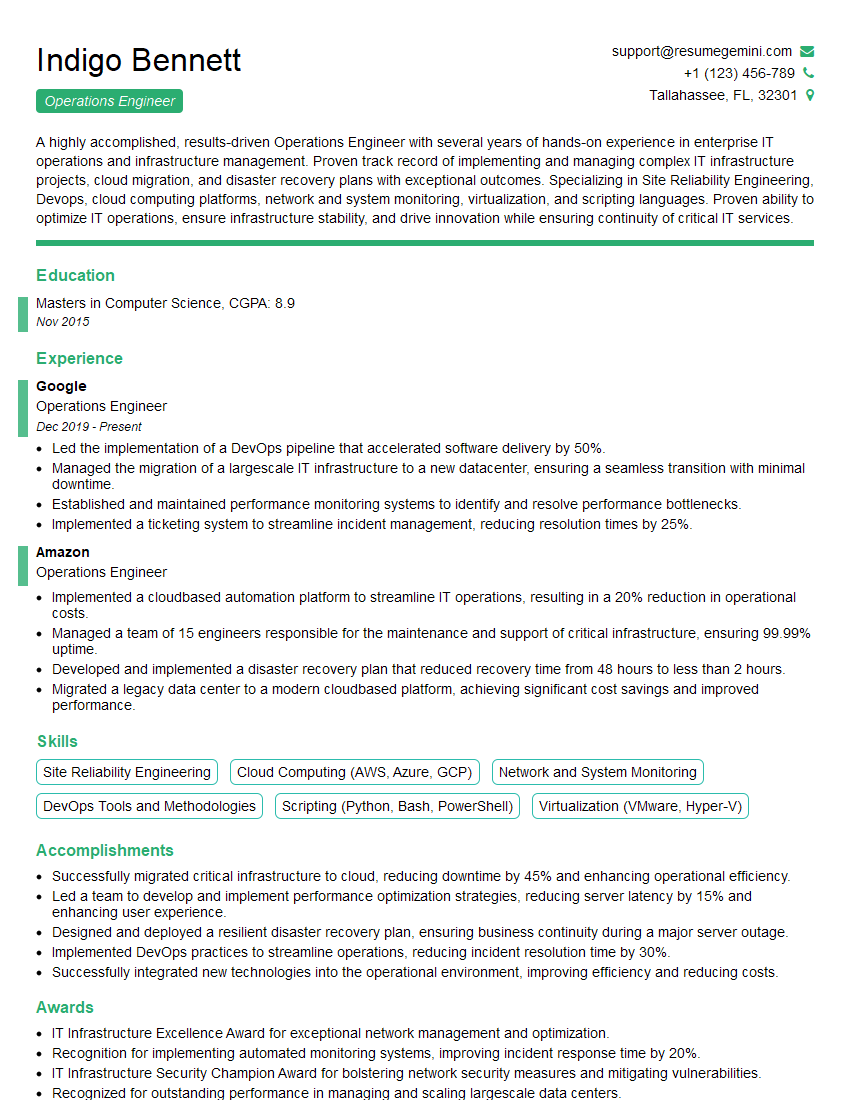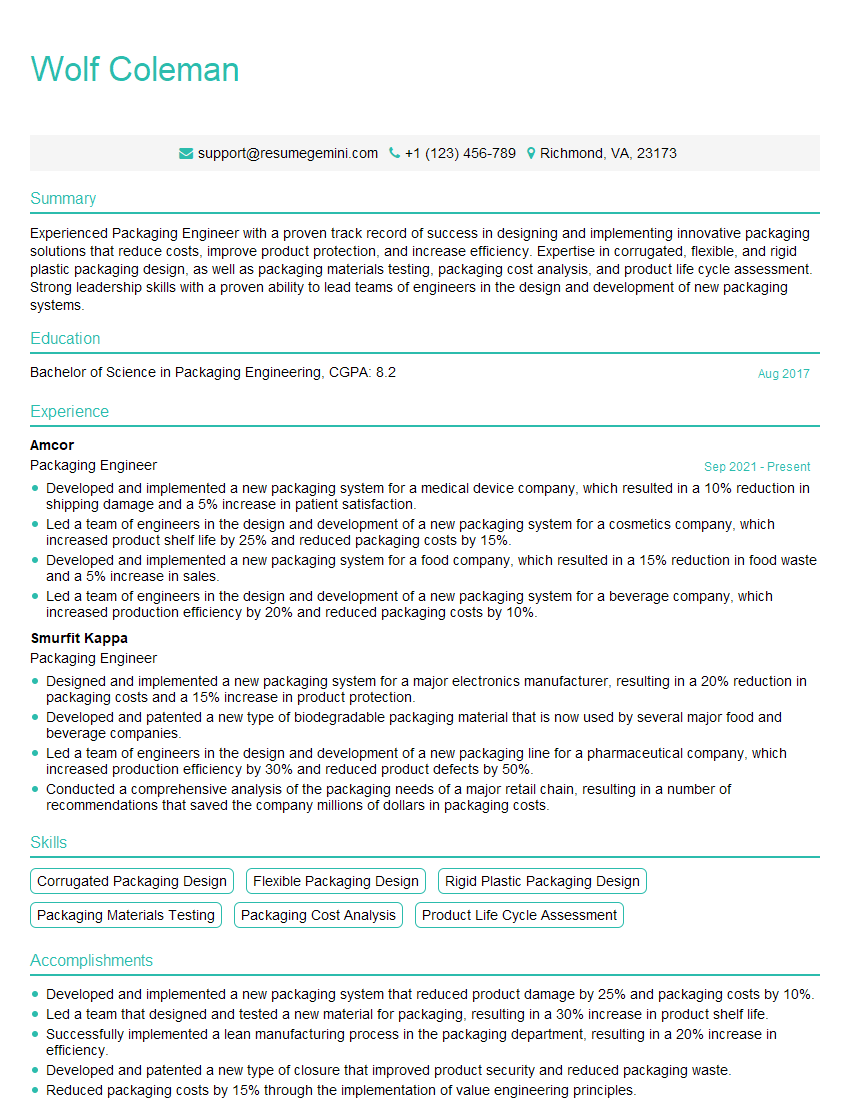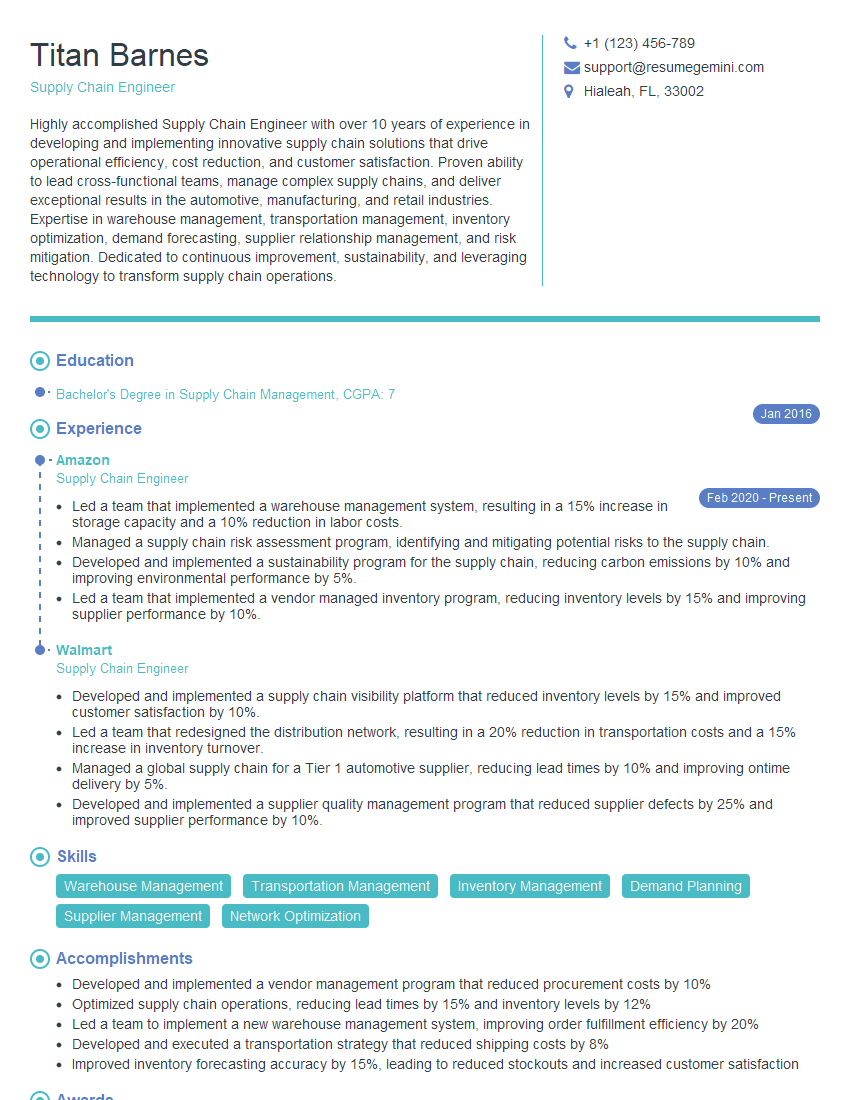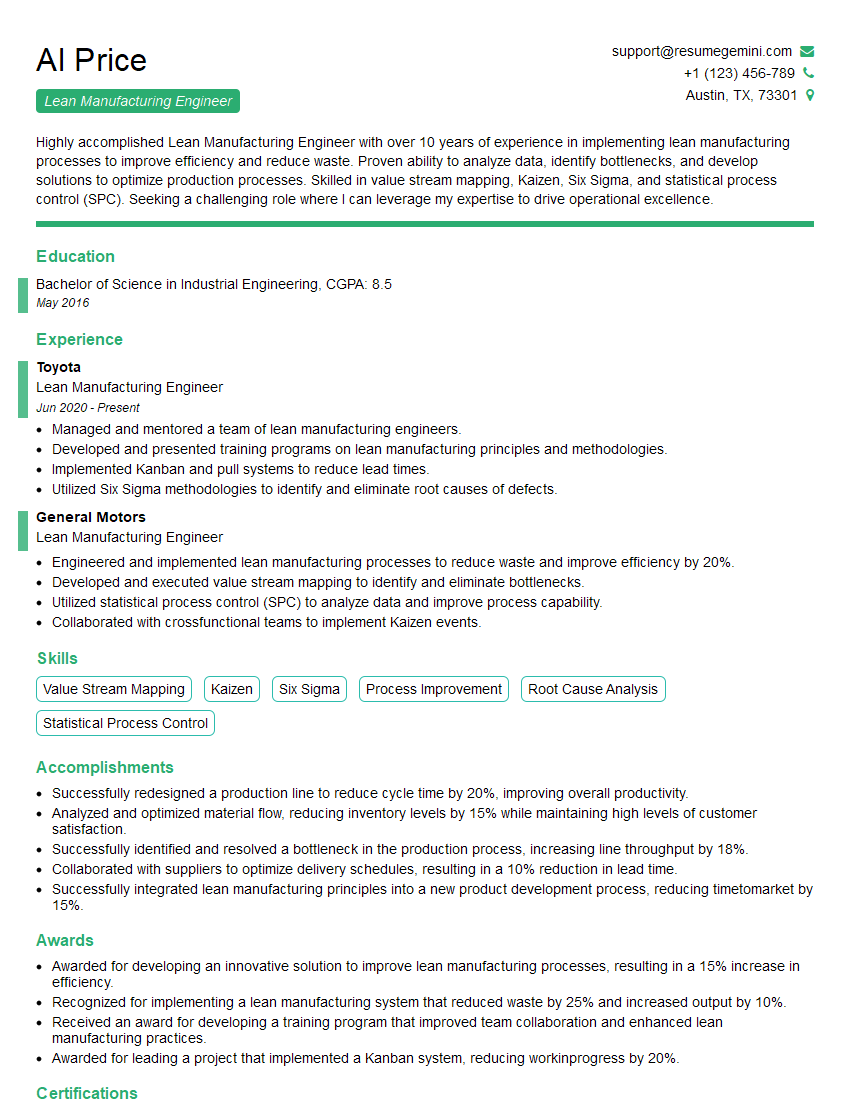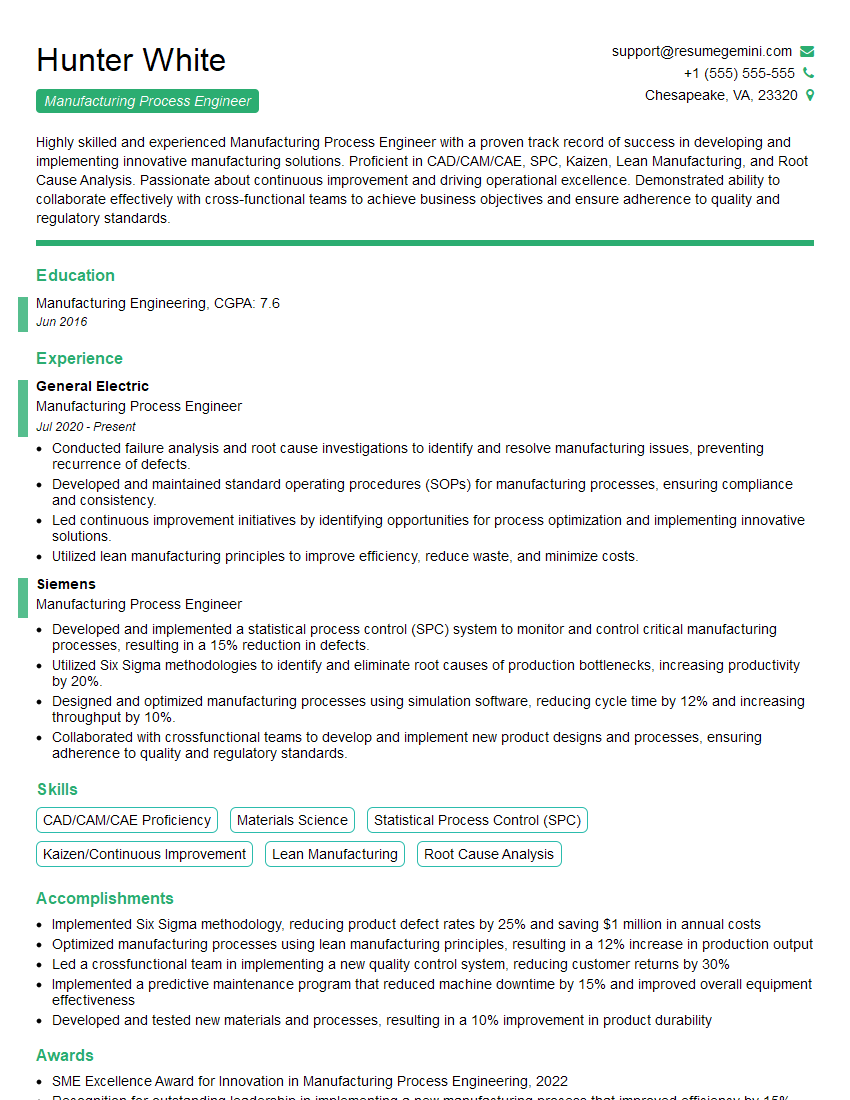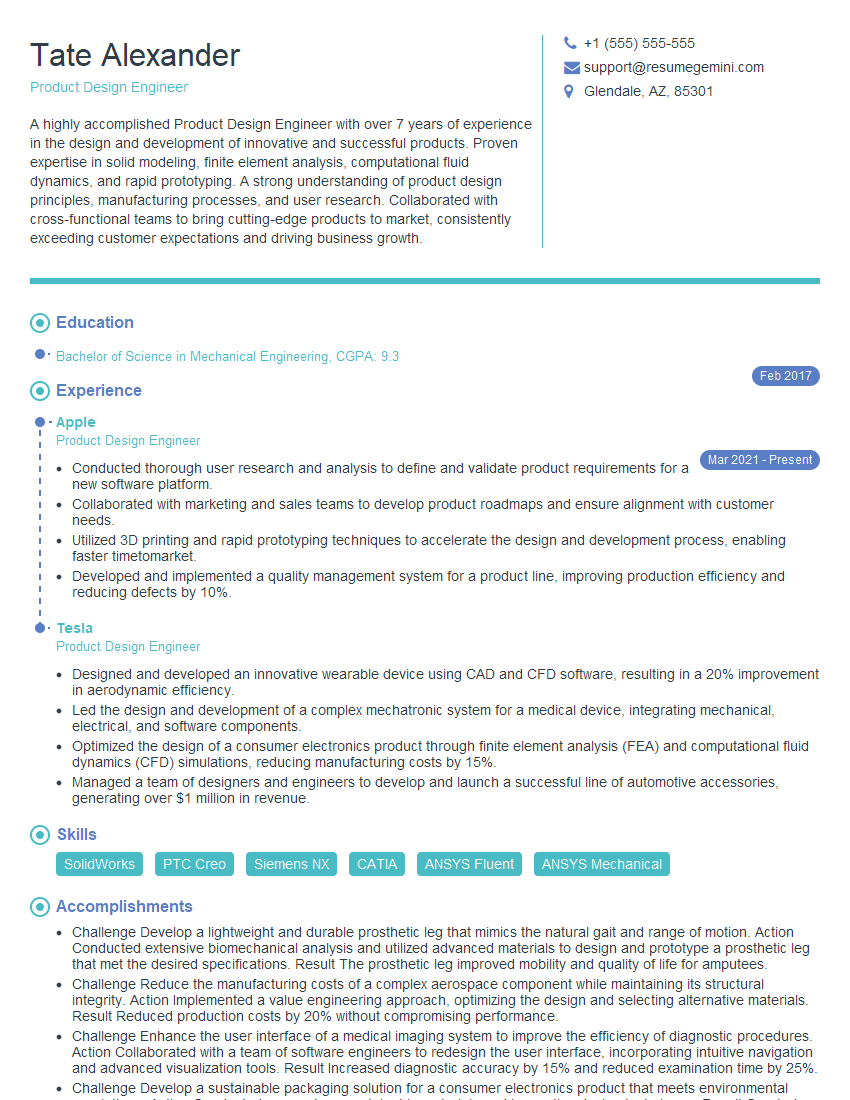The right preparation can turn an interview into an opportunity to showcase your expertise. This guide to Design for Assembly and Manufacture interview questions is your ultimate resource, providing key insights and tips to help you ace your responses and stand out as a top candidate.
Questions Asked in Design for Assembly and Manufacture Interview
Q 1. Explain the principles of Design for Assembly (DFA).
Design for Assembly (DFA) focuses on simplifying the assembly process to reduce costs, improve quality, and shorten lead times. It’s all about making a product easier and cheaper to put together. Think of it like building with LEGOs – a well-designed set goes together smoothly, while a poorly designed one is frustrating and time-consuming.
- Minimize parts: Fewer parts mean less assembly time and lower costs. This often involves combining multiple parts into one or using modular designs.
- Simplify part geometry: Avoid complex shapes and features that require specialized tools or intricate handling. Simple shapes are easier and faster to assemble.
- Use standardized parts: Employing common, readily available parts reduces costs and simplifies procurement.
- Design for self-alignment: Parts should align easily during assembly, minimizing the need for precise adjustments or tooling.
- Improve accessibility: Parts should be easily accessible during assembly, avoiding the need to disassemble other components.
- Utilize efficient joining methods: Choose joining methods like snap-fits, press-fits, or screws that are quick and reliable.
For example, consider a cell phone. A well-designed DFA phone will have a modular design, allowing for easy replacement of components like the battery and screen. Each component snaps into place easily, reducing assembly time and the need for specialized tools. Conversely, a poorly designed phone might require the disassembly of multiple parts to access the battery, increasing labor costs and time.
Q 2. Describe the principles of Design for Manufacturing (DFM).
Design for Manufacturing (DFM) centers on making a product easy and cost-effective to produce. It’s about optimizing the design to suit the manufacturing process and available resources. Imagine baking a cake: a well-designed recipe (DFM) accounts for the available ingredients and tools, producing a consistently good result.
- Material selection: Choosing appropriate materials based on cost, availability, machinability, and performance characteristics.
- Process optimization: Selecting the most efficient manufacturing processes based on volume, required tolerances, and available equipment (e.g., injection molding, machining, casting).
- Tolerances: Defining manufacturing tolerances that are achievable and cost-effective. Tight tolerances increase cost and complexity.
- Reduce machining operations: Designing parts with features that minimize the number of machining steps reduces manufacturing time and expense.
- Surface finish considerations: Considering surface finish requirements early in the design phase influences the choice of manufacturing processes and reduces post-processing needs.
- Assembly considerations within manufacturing: Thinking about the assembly of sub-assemblies during manufacturing can greatly improve efficiency.
Consider a plastic part. DFM principles would guide the choice of plastic material based on cost, strength, and the chosen molding process. The design would also consider the ease of molding, minimizing the complexity and cost of the tooling required.
Q 3. What is the difference between DFA and DFM?
While both DFA and DFM aim to improve product design, they focus on different aspects of the product lifecycle. DFA primarily targets assembly, while DFM focuses on the overall manufacturing process. Think of building a house: DFA focuses on how easily the walls, roof, and windows go together, whereas DFM focuses on the best way to manufacture each component – whether to use prefabricated walls, cast concrete, or build from scratch.
DFA concentrates on reducing assembly time, cost, and complexity. DFM, on the other hand, aims to reduce manufacturing time, cost, and complexity, encompassing material selection, process optimization, and tooling. Although distinct, DFA and DFM are highly interconnected. A good DFM design will often lead to a better DFA design, and vice-versa. For instance, choosing a material that can be easily molded (DFM) will also likely make assembly easier (DFA).
Q 4. How do you assess the manufacturability of a design?
Assessing manufacturability involves a thorough evaluation of the design’s feasibility and cost-effectiveness from a manufacturing perspective. This is a crucial step before committing to production.
- Design Review: A cross-functional team (design engineers, manufacturing engineers, procurement) should review the design to identify potential manufacturability issues.
- Process Simulation: Utilize simulation tools (e.g., finite element analysis, mold flow analysis) to predict the manufacturing process’s performance and potential challenges.
- Prototype Testing: Building and testing prototypes helps to identify any unforeseen issues or limitations in the manufacturing process.
- Cost Estimation: Performing detailed cost estimations for different manufacturing processes aids in making informed decisions.
- Material Selection Analysis: Evaluate the suitability of the selected materials based on the manufacturing process and end-use requirements.
- Tolerance Analysis: Analyze the impact of manufacturing tolerances on the final product’s functionality and performance.
For instance, a complex part requiring many machining steps might be deemed unmanufacturable unless simplified or redesigned for a more suitable process, such as injection molding. Prototyping allows for hands-on evaluation of manufacturing challenges and cost effectiveness early on.
Q 5. Explain your experience with tolerance analysis in DFAM.
Tolerance analysis is crucial in DFAM as it identifies how variations in part dimensions and tolerances affect the final assembly. I have extensive experience using statistical tolerance analysis methods like worst-case analysis and root-sum-square (RSS) analysis. Worst-case analysis assumes that all tolerances accumulate in the worst possible direction, resulting in a conservative estimate. RSS analysis uses statistical methods to better account for the probability of various tolerance combinations.
In a recent project involving the design of a precision instrument, we used Monte Carlo simulation to analyze tolerance stack-up. This involved simulating thousands of assemblies with random variations within the defined tolerances, and determining the probability of the assembly failing to meet its functional requirements. This allowed us to identify critical tolerances needing tighter control and those where some relaxation wouldn’t impact functionality. This data drove manufacturing process improvements and helped us balance cost and performance requirements effectively.
Q 6. How do you reduce the number of parts in an assembly?
Reducing the number of parts is a key goal of DFA. Several strategies can be employed:
- Part Integration: Combining multiple parts into a single component through design changes, for example, using a single molding process instead of multiple parts joined together.
- Modular Design: Creating a modular system where larger assemblies are made of smaller, interchangeable modules. This reduces the total number of unique parts while offering flexibility in assembly.
- Component Standardization: Using the same part in multiple locations within the assembly, thus reducing the overall number of unique parts needed.
- Functional Consolidation: Designing a part to perform multiple functions, eliminating the need for separate parts.
For instance, a simple example is integrating multiple plastic housings into a single injection-molded part rather than using screws or adhesives to assemble several smaller parts. This eliminates joining steps, simplifies assembly, reduces manufacturing costs, and improves the overall product robustness.
Q 7. How do you simplify assembly processes?
Simplifying assembly processes involves focusing on ease of handling, alignment, and joining. Here’s how it’s done:
- Self-mating features: Designing parts with features that guide themselves into proper alignment during assembly, such as guides, chamfers, and snap fits.
- Simplified joining methods: Utilizing simple joining methods like press fits, snap fits, or screw-less fasteners which speeds up the process and reduces cost.
- Accessibility improvements: Ensure all assembly points are easily accessible, and parts are designed with ergonomic considerations in mind. This can reduce assembly time and error.
- Use of automation: Investigate and design for automation where feasible, particularly for high-volume production. This can dramatically improve speed and consistency.
- Visual aids: Designing clear visual indicators and assembly instructions to reduce errors and training time.
For example, designing parts with snap-fit features eliminates the need for screws or adhesives, making assembly much quicker and easier. Furthermore, using clear visual aids such as color-coding or embossed guides on the parts helps even unskilled laborers assemble the product efficiently.
Q 8. Describe your experience using DFAM software or tools.
My experience with DFAM software and tools is extensive. I’ve worked extensively with industry-standard software such as Autodesk Inventor, SolidWorks, and Siemens NX, leveraging their integrated DFAM functionalities for design analysis and optimization. These tools allow for detailed simulations of assembly processes, identifying potential bottlenecks and areas for improvement early in the design stage. For instance, I used SolidWorks’ assembly simulation feature to analyze the assembly sequence of a complex medical device, revealing a sub-optimal fastener design that was causing delays. This allowed us to redesign the fastener and significantly reduce assembly time and labor costs. Beyond specific software, I’m also proficient in utilizing tools like tolerance analysis software (e.g., CETOL) to ensure manufacturability and part compatibility. This proactive approach helps minimize costly rework and production delays.
Q 9. How do you incorporate ergonomics into your DFAM designs?
Ergonomics is a critical component of successful DFAM. Ignoring human factors can lead to inefficient assembly processes, increased injury risk, and decreased worker satisfaction. I incorporate ergonomics into my designs through various methods. This starts with understanding the anthropometrics (human body measurements) of the target assembly workers. I use this data to design handles, grips, and overall product geometry that fit comfortably within the worker’s reach and minimize strain. For example, during the design of a consumer electronics product, I used anthropometric data to determine the optimal size and placement of buttons and control interfaces, ensuring accessibility for users with a wide range of hand sizes. Furthermore, I use virtual reality (VR) and augmented reality (AR) simulations to evaluate assembly tasks from the worker’s perspective, allowing for early detection and correction of ergonomic issues before prototyping.
Q 10. Explain your approach to identifying and resolving assembly issues.
My approach to identifying and resolving assembly issues is systematic and proactive. It involves a multi-step process beginning with a thorough review of the design using DFAM principles. I employ techniques such as Design Failure Mode and Effects Analysis (DFMEA) to anticipate potential problems early on. I then conduct detailed assembly simulations (both digital and physical mock-ups) to identify potential bottlenecks or interference issues. This might involve analyzing the number of parts, fasteners, and the complexity of assembly sequences. For example, in a recent project involving the assembly of a complex engine component, I discovered a hidden interference during the simulation phase. This allowed for a simple redesign before tooling costs were incurred. If issues are identified, I employ a structured problem-solving methodology such as the 8D report to understand the root cause, implement corrective actions, and verify their effectiveness, ensuring documentation throughout the process.
Q 11. How do you balance cost and manufacturability in your designs?
Balancing cost and manufacturability is a constant challenge in DFAM. My approach is to consider manufacturing cost estimations early in the design phase, comparing different manufacturing processes and materials. I use cost modeling software to compare the costs associated with different design alternatives, evaluating factors such as material costs, tooling costs, labor costs, and manufacturing lead times. For example, when designing a plastic housing, I considered using injection molding for high-volume production despite its higher tooling cost. This resulted in significant cost savings per unit compared to using alternative methods like machining. I utilize Design for Manufacturing (DFM) guidelines, focusing on simple geometries, minimizing the number of parts, and choosing standard components to reduce manufacturing complexity and cost. The goal is to find the optimal solution that minimizes cost without compromising product quality or functionality.
Q 12. Describe your experience with different manufacturing processes (e.g., injection molding, machining).
I have extensive experience with a wide array of manufacturing processes. My experience with injection molding includes designing parts for optimal moldability, considering factors such as draft angles, wall thicknesses, and ejection mechanisms. In machining, my knowledge spans various processes like milling, turning, and drilling, optimizing designs for ease of machining and minimizing material waste. For example, I designed a complex metal part for a high-precision instrument using 5-axis milling, considering the toolpath and material removal strategies to maximize efficiency. My experience also extends to sheet metal fabrication, understanding bending radii, punch limitations, and efficient part nesting. I also have familiarity with additive manufacturing (3D printing) techniques and their use in prototyping and small-scale production. This broad understanding allows me to select the optimal manufacturing process for any given design, considering cost, lead times, and material properties.
Q 13. How do you incorporate sustainability considerations into your DFAM designs?
Sustainability is increasingly important in product design, and I integrate sustainable practices throughout the DFAM process. This involves using recycled materials whenever possible and choosing materials with low environmental impact. I also aim to minimize material usage, reducing waste during manufacturing and the product’s lifecycle. For instance, I might use lightweight materials like aluminum alloys to reduce transportation costs and emissions. Design for Disassembly (DFD) is another key element, enabling easier recycling or reuse at the end of the product’s life. Modular design, allowing for component replacement instead of whole-product replacement, also contributes to sustainability. Life cycle assessment (LCA) tools help evaluate the environmental impact of the entire product lifecycle, from raw material extraction to disposal, enabling informed material and process choices. This comprehensive approach ensures that my designs are not only functional and efficient but also environmentally responsible.
Q 14. How do you manage design changes during the manufacturing process?
Managing design changes during the manufacturing process requires a structured and collaborative approach. Clear communication and documentation are critical. I utilize a formal change management system, documenting all design changes meticulously, including the reasons for the change, its impact on the manufacturing process, and the associated costs. This ensures transparency and accountability. When changes are necessary, I work closely with manufacturing engineers to assess the impact of these changes on the existing tooling and production processes. We evaluate the feasibility and cost of implementing the changes, minimizing disruption to the production line. Simulation tools are used to validate that the design changes don’t introduce new problems, ensuring a smooth transition into manufacturing. This coordinated effort minimizes delays, cost overruns, and quality issues resulting from late-stage design modifications.
Q 15. What are some common DFAM pitfalls to avoid?
Avoiding pitfalls in Design for Assembly and Manufacture (DFAM) is crucial for producing high-quality products efficiently. Common mistakes often stem from a lack of communication, insufficient upfront planning, or neglecting manufacturing constraints. Here are some key pitfalls to avoid:
- Ignoring Manufacturing Capabilities: Designing parts that require specialized, expensive, or unavailable manufacturing processes leads to delays and increased costs. For instance, specifying a surface finish that’s impossible with the chosen manufacturing method is a common error.
- Complex Assembly Procedures: Overly complex designs with many small parts, intricate fastening mechanisms, or poor part orientation increase assembly time, labor costs, and the risk of errors. Think of assembling a complex clock versus a simple toy – the former requires specialized tools and higher skill level.
- Poor Part Design for Handling: Parts that are difficult to grip, orient, or feed into automated assembly lines increase production time and errors. For example, small, identical parts with no distinguishing features are prone to being mistakenly assembled incorrectly.
- Lack of Standardization: Using non-standard parts or fasteners leads to increased inventory costs and procurement difficulties. A simple example is using custom screws instead of readily available standard screws.
- Insufficient Tolerance Analysis: Failing to account for manufacturing tolerances can lead to parts that don’t fit together properly, causing assembly problems or product malfunction. The tighter the tolerances, the more expensive manufacturing becomes.
- Ignoring Ergonomics: Poorly designed products that are difficult or uncomfortable for workers to assemble can lead to reduced productivity, increased injury risk, and lower quality.
By proactively addressing these potential problems early in the design process through thorough planning, collaboration with manufacturing, and rigorous testing, you can significantly improve product manufacturability and reduce costs.
Career Expert Tips:
- Ace those interviews! Prepare effectively by reviewing the Top 50 Most Common Interview Questions on ResumeGemini.
- Navigate your job search with confidence! Explore a wide range of Career Tips on ResumeGemini. Learn about common challenges and recommendations to overcome them.
- Craft the perfect resume! Master the Art of Resume Writing with ResumeGemini’s guide. Showcase your unique qualifications and achievements effectively.
- Don’t miss out on holiday savings! Build your dream resume with ResumeGemini’s ATS optimized templates.
Q 16. Describe your experience with failure mode and effects analysis (FMEA).
Failure Mode and Effects Analysis (FMEA) is a systematic method for identifying potential failure modes in a system and assessing their severity, occurrence, and detectability. My experience with FMEA involves leading cross-functional teams to conduct thorough analyses for various products, from consumer electronics to medical devices.
In a typical FMEA, we start by defining the system or product and breaking it down into its constituent parts and functions. Then, for each part or function, we brainstorm potential failure modes, their effects on the system, the severity of these effects, the likelihood of occurrence (occurrence rate), and the likelihood of detecting the failure before it impacts the customer (detection rate). We use a risk priority number (RPN) calculated as Severity x Occurrence x Detection to prioritize the failure modes requiring the most immediate attention.
For instance, in a recent project involving a new medical device, our FMEA identified a potential failure mode related to a faulty sensor. Through this analysis, we determined the severity of this failure was high (potential harm to the patient), the occurrence probability was low, but the detection probability was also low. This highlighted the need for stringent quality control procedures during sensor manufacturing and testing to mitigate the risk despite low occurrence.
Following the FMEA, we develop corrective actions to reduce the RPN of critical failure modes. These actions might involve design modifications, improved testing procedures, or enhanced manufacturing processes. We then track the effectiveness of these actions over time to ensure they maintain the desired level of product reliability and safety.
Q 17. How do you use Design for Six Sigma (DFSS) principles in your work?
Design for Six Sigma (DFSS) is a methodology that integrates statistical analysis and engineering principles to design products and processes that consistently meet customer requirements and minimize defects. I utilize DFSS principles throughout the design process, ensuring quality is built into the product from the outset, rather than trying to inspect quality in later stages.
My approach usually follows DMAIC (Define, Measure, Analyze, Improve, Control) or DMADV (Define, Measure, Analyze, Design, Verify), depending on whether we’re improving an existing product or designing a new one. For example, in the DMAIC phase, we use statistical tools to define critical-to-quality (CTQ) characteristics based on customer needs. We measure current performance and analyze the root causes of defects, using tools like process capability analysis and Design of Experiments (DOE).
In the Design phase (DMADV), I employ robust design techniques to create designs that are less sensitive to process variation. For example, I might use tolerance analysis to determine the impact of variations in manufacturing on the final product performance. Through Design of Experiments, I can optimize design parameters to minimize the variation around the target value while adhering to all DFAM principles.
Finally, verification and validation steps are crucial to confirm that the design meets the specified CTQs and the manufacturing process is capable of consistently producing products within the required tolerances. This involves extensive testing and validation across the whole supply chain.
Q 18. How do you collaborate with manufacturing teams during the design process?
Collaboration with manufacturing teams is absolutely essential for successful DFAM. I believe in a highly collaborative approach where manufacturing engineers are involved from the very beginning of the design process. This proactive involvement ensures designs are realistic, manufacturable, and cost-effective.
I facilitate regular meetings and workshops involving design, manufacturing, and quality engineers. These sessions use tools like Design Reviews and Failure Modes and Effects Analysis (FMEA) to identify and address potential problems early on. We also leverage digital tools for design collaboration, such as cloud-based CAD platforms that allow real-time feedback and modifications.
For example, during the design of a complex assembly, we might use a virtual assembly simulation to identify potential fit issues or ergonomic challenges. This allows us to make design changes before physical prototypes are built, saving time and resources. In addition, I regularly visit manufacturing facilities to observe existing processes and gain a better understanding of the capabilities and limitations of the manufacturing equipment. This direct observation is invaluable for creating effective and realistic designs.
Q 19. Explain your experience with Design for X (DFX) methodologies.
Design for X (DFX) encompasses a range of methodologies that optimize a product for various aspects of its lifecycle. My experience spans several DFX methodologies, including Design for Assembly (DFA), Design for Manufacturing (DFM), Design for Test (DFT), Design for Reliability (DFR), and Design for Environment (DFE). These are not isolated approaches but rather interconnected elements of a holistic design strategy.
In DFA, I focus on simplifying the assembly process to reduce costs, improve quality, and increase production speed. DFM considers the manufacturability of the design, ensuring parts are easily produced using available manufacturing processes and equipment. DFT incorporates design features that facilitate efficient testing during production and in the field. DFR aims to increase product reliability and longevity through robust design choices and materials selection. Finally, DFE promotes environmentally friendly materials and manufacturing processes.
For a specific example, in a recent project involving a medical device, we employed DFR by using robust material selection to withstand various environments and stresses, minimizing material waste during manufacturing (DFM), and designed for ease of assembly and testing (DFA and DFT). This integrated DFX approach resulted in a highly reliable product with a low environmental impact.
Q 20. How do you utilize CAD software for DFAM?
CAD software is indispensable for DFAM. I use CAD extensively for creating and analyzing 3D models of products and assemblies. Beyond simple part modeling, I leverage the advanced capabilities of CAD software for DFAM in several ways:
- Digital Mock-ups and Assemblies: I create digital mock-ups of the product to virtually assemble components and assess fit, interference, and accessibility. This allows for early detection and correction of design flaws, saving time and resources during prototyping.
- Tolerance Analysis: CAD software with built-in tolerance analysis capabilities helps determine the impact of manufacturing tolerances on assembly and product performance. This ensures designs are robust and less sensitive to variations in manufacturing.
- Finite Element Analysis (FEA): I utilize FEA to simulate the structural behavior of components under various loads and conditions. This helps optimize designs for strength, durability, and reliability while adhering to weight and size constraints.
- Design for Manufacturing Rules and Checks: Modern CAD software includes tools and rules that check designs against manufacturability standards. These checks identify potential issues early, such as undercuts, excessive draft angles, or features difficult to machine.
- Collaboration and Data Sharing: CAD software facilitates collaboration with manufacturing teams by enabling easy sharing of design data and models. This ensures everyone involved has access to the latest design revisions and can provide timely feedback.
In short, CAD software is not just a design tool; it’s a critical element in my DFAM workflow, providing essential insights and analyses throughout the design and development phases.
Q 21. How do you define and measure assembly efficiency?
Assembly efficiency is a measure of how quickly and effectively a product can be assembled. It’s a crucial metric in DFAM, representing a balance between speed and quality. Defining and measuring assembly efficiency involves a multifaceted approach.
Defining Assembly Efficiency: We define it by considering several factors, including:
- Assembly Time: The total time required to assemble one unit of the product.
- Number of Parts: The total number of individual components required for assembly.
- Assembly Operations: The number of steps involved in the assembly process.
- Labor Cost: The cost of labor associated with assembly.
- Defect Rate: The percentage of assembled units that contain defects.
Measuring Assembly Efficiency: Measuring these factors can involve different techniques:
- Time Studies: Observing and timing the assembly process to determine the time required for each step.
- Work Sampling: Randomly observing assembly operations to estimate the proportion of time spent on different tasks.
- Motion Studies: Analyzing the movements of assemblers to identify inefficiencies and areas for improvement.
- Simulation Software: Using simulation software to model the assembly process and predict assembly time and defect rates.
- Key Performance Indicators (KPIs): Tracking relevant KPIs like assembly time per unit, defect rate, and labor cost per unit over time to monitor progress and identify areas of improvement.
By systematically evaluating these factors, we can quantify assembly efficiency and identify areas for optimization. Improvements may involve redesigning parts, simplifying the assembly process, or implementing automation to enhance overall productivity and quality.
Q 22. Describe your experience with different types of fasteners and joining methods.
My experience with fasteners and joining methods spans a wide range, from simple screws and rivets to more complex solutions like adhesives, welds, and snap fits. Understanding the strengths and weaknesses of each is crucial for DFAM. For instance, screws offer easy disassembly and adjustability but can be time-consuming to install, especially in high-volume production. Rivets provide strong, permanent joints ideal for aerospace applications, but require specialized tooling. Adhesives are excellent for joining dissimilar materials and creating aesthetically pleasing joints, but curing times and environmental factors need careful consideration. Welding is incredibly strong and efficient for metal components but might introduce heat distortion or require specialized skills. Finally, snap fits, cleverly designed interlocking parts, eliminate the need for separate fasteners, speeding up assembly and reducing costs, but require precise design and material selection to ensure reliable performance.
- Screws: Versatile, easily disassembled, but slower assembly.
- Rivets: Strong, permanent, but require specialized tooling.
- Adhesives: Ideal for dissimilar materials, but curing time is critical.
- Welding: Strong, efficient, but may cause distortion.
- Snap Fits: Fast assembly, cost-effective, but requires precise design.
Q 23. How do you handle material selection considerations for manufacturability?
Material selection is paramount for manufacturability. I approach it systematically, considering factors such as cost, availability, machinability, strength, durability, and environmental impact. For example, using readily available, easily machinable materials like aluminum alloys reduces manufacturing costs and lead times. However, if strength is paramount, a high-strength steel might be preferable despite higher costs and more complex machining. Sustainability is also a key concern; I often explore bio-based materials or recycled options to minimize the environmental footprint. The selection process often involves trade-offs; a cost-effective material might require more complex tooling, leading to higher tooling costs. My approach involves careful analysis and simulation to optimize the material choice for overall cost-effectiveness and performance.
For instance, in a project involving a high-volume consumer product, we initially considered using a high-strength polymer for its lightweight properties. However, its higher cost and relatively challenging molding process were deemed unsuitable. We opted for a more cost-effective and easily moldable ABS plastic, which yielded better overall manufacturability without compromising the required product strength.
Q 24. What are some key metrics you use to evaluate the success of a DFAM project?
Evaluating DFAM project success isn’t solely about cost reduction. I employ a multi-faceted approach using key metrics like:
- Reduced assembly time: Measured in seconds/unit or labor hours.
- Lower manufacturing cost: Tracking material, labor, and tooling costs.
- Improved quality: Reducing defects and improving consistency through better design.
- Simplified assembly process: Fewer steps and simpler tools result in increased efficiency.
- Reduced part count: Fewer parts directly translate to lower costs and simpler assembly.
- Increased product reliability: Robust design translates to fewer failures and returns.
These metrics are tracked throughout the project and compared to pre-DFAM design performance. A successful project shows significant improvement across multiple metrics, not just a single one.
Q 25. How do you incorporate testing and validation into your DFAM workflow?
Testing and validation are integral to the DFAM workflow. I integrate them at every stage, from initial concept design to final production. This includes:
- Prototyping: Creating physical prototypes to validate design features and manufacturability.
- Finite Element Analysis (FEA): Simulating stress and strain to ensure structural integrity.
- Computer-aided manufacturing (CAM) simulations: Testing the effectiveness of manufacturing processes before actual production.
- Assembly process simulation: Using digital twins to identify potential assembly issues before production.
- Durability testing: Evaluating the product’s resistance to wear and tear under various conditions.
- Pilot runs: Performing small-scale production runs to identify any unforeseen issues.
This iterative approach helps identify and rectify potential problems early, reducing rework, delays, and ultimately costs.
Q 26. Explain your experience with automation in assembly processes.
My experience with automation in assembly encompasses various technologies, including robotic arms, automated guided vehicles (AGVs), and specialized assembly machines. Automation is key for high-volume production, improving consistency, reducing labor costs, and increasing throughput. I’ve worked on projects where robotic arms performed intricate tasks like inserting small components, applying adhesives, and performing quality checks. AGVs efficiently transport parts between workstations, optimizing material flow. Specialized assembly machines, tailored to specific products, can drastically reduce assembly time and improve overall efficiency. However, implementing automation requires careful planning and consideration of factors like initial investment costs, ROI, and potential integration challenges with existing systems.
In one project, we implemented a robotic arm for inserting a small electronic component into a complex housing. This automation reduced assembly time by 60% and significantly improved the consistency of the assembly process, resulting in a lower defect rate.
Q 27. Describe a challenging DFAM project and how you overcame the obstacles.
A particularly challenging project involved redesigning a complex medical device with numerous small, delicate components. The initial design was difficult to assemble, resulting in high labor costs and a high defect rate. The challenge was to redesign it for ease of assembly without compromising functionality or safety. We employed a multi-pronged approach:
- Design for X (DFX): We applied DFX principles, considering factors such as assembly (DFA), manufacturing (DFM), and testing (DFT).
- Modular design: We redesigned the device using a modular approach, breaking down the assembly into smaller, more manageable sub-assemblies.
- Simplified parts: We streamlined the design, reducing the number of parts and simplifying their geometry.
- Improved fastening methods: We switched from screws to snap fits and other simpler fasteners.
- Tooling optimization: We designed custom tooling to aid in the assembly process.
Through this systematic approach, we reduced assembly time by 75%, lowered manufacturing costs by 40%, and significantly improved the product’s reliability.
Q 28. How would you approach redesigning a product for improved manufacturability?
Redesigning a product for improved manufacturability starts with a thorough analysis of the current design. I’d use a structured approach focusing on several key areas:
- Part count reduction: Combining parts, using multi-functional components, or eliminating unnecessary features.
- Simplification of geometry: Eliminating complex curves and undercuts to facilitate easier machining or molding.
- Standardization of parts: Using standard parts and fasteners reduces costs and simplifies procurement.
- Improved material selection: Choosing materials that are more easily machinable or moldable, readily available, and cost-effective.
- Optimization of assembly sequence: Designing the product for easier and more efficient assembly, possibly using gravity assist or modular design.
- Tolerance analysis: Ensuring that tolerances are achievable and minimize manufacturing errors.
This process typically involves iterations of design, simulation, and prototyping until a manufacturable and cost-effective design is achieved. The ultimate goal is to create a product that is easier to assemble, manufacture, and maintain while meeting all functional and performance requirements.
Key Topics to Learn for Design for Assembly and Manufacture Interview
- Assembly Sequence Planning: Understand how to optimize the order of assembly operations to minimize time, cost, and complexity. Consider factors like part accessibility, tooling requirements, and ergonomics.
- Part Design for Manufacturability (DFM): Explore techniques for designing parts that are easily and cost-effectively manufactured. This includes understanding tolerances, material selection, and manufacturing processes like injection molding, machining, and 3D printing.
- Tolerance Stack-up Analysis: Learn to analyze how variations in individual part dimensions accumulate to affect the overall assembly. Master techniques for minimizing tolerance stack-up and ensuring proper fit and function.
- Modular Design: Understand the principles of modular design and how it simplifies assembly, reduces costs, and allows for easier product variation and maintenance.
- Fasteners and Joining Techniques: Become proficient in selecting appropriate fasteners and joining methods based on factors such as strength, cost, and ease of assembly. Consider different types of screws, rivets, welds, and adhesives.
- Ergonomics and Human Factors: Explore the importance of designing for human operators. Consider factors like reach, force, and posture to ensure efficient and safe assembly processes.
- Automation and Robotics in Assembly: Understand the role of automation and robotics in modern assembly processes. Discuss the advantages and challenges of implementing automated assembly systems.
- Sustainability and Environmental Considerations: Discuss environmentally friendly design practices within the context of Design for Assembly and Manufacture (DFAM), including material selection, waste reduction, and energy efficiency.
- Cost Analysis and Optimization: Learn to evaluate the manufacturing costs associated with different design choices and identify opportunities for cost reduction throughout the product lifecycle.
- Problem-Solving and Troubleshooting: Develop skills in identifying and resolving assembly problems, including analyzing root causes, implementing corrective actions, and preventing future occurrences.
Next Steps
Mastering Design for Assembly and Manufacture significantly enhances your career prospects in engineering and manufacturing. It showcases your ability to design practical, cost-effective, and manufacturable products. To stand out, create an ATS-friendly resume that highlights your skills and experience effectively. ResumeGemini is a trusted resource that can help you build a professional and impactful resume. We provide examples of resumes tailored to Design for Assembly and Manufacture to guide you in crafting your own compelling application.
Explore more articles
Users Rating of Our Blogs
Share Your Experience
We value your feedback! Please rate our content and share your thoughts (optional).
What Readers Say About Our Blog
good








